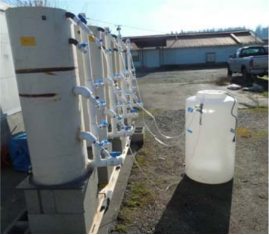Structures such as rain gardens and bioretention swales, collectively known as low impact development (LID) structures, are being widely promoted as a cost-effective way to both reduce flooding associated with urban runoff and improve water quality. Municipalities in the Pacific Northwest are enthusiastically adopting these structures, but little is known about how these systems process important pollutants including nitrogen or how these systems will respond to climate change, which is anticipated to cause more frequent, more intense precipitation in the Pacific Northwest. This work provides insight into the effects of storm intensity and frequency on water flow, soil N processing, surface and subsurface N retention, and greenhouse gas production in LID systems. In so doing, the work directly addresses the following State of Washington Water Research Center priority areas: 1) climate change effects on water supply, demand, and quality, and 2) fate and transport of nutrients and emerging contaminants in the environment.
Specifically, we used mesocosm soil columns at the WA Stormwater Research Center to test how N retention and greenhouse gas production in bioretention swale soils responds to rain events of increasing intensity and varying frequency. This work advances fundamental understanding of interactions between soil N processing and climate and provides information that is critically needed by municipal, county, and state-level decision-makers. Furthermore, our project has high training potential as it would directly support the career development of two female assistant professors (Moffett at WSU, Vancouver and Morse at PSU) and two MS students, while catalyzing exciting new collaborations both across multiple WSU campuses and between institutions (WSU and PSU). We intend that this project will result in successful dissemination of results via presentations at national meetings, publication in high-profile journals, and through WSU Puyallup’s extension machinery. Data generated through this effort will contribute to compelling follow-up proposals to relevant agencies and programs such as WA Department of Ecology’s stormwater grants program and NSF Hydrology.
For more information click here.
Activities and Products
- Understanding Stormwater Nitrogen Pathways in Bioretention Swales
- Effects of Heavy Precipitation Events on NO3- Dynamics in Conventional vs Low Impact Development Stormwater Catchments
- Quantifying Denitrification in Bioretention Swales under Unsaturated Conditions
- Effects of storm size and frequency on N retention, denitrification, and greenhouse gas production in bioretention mesocosms
- Effects of storm size and frequency on nitrogen retention, denitrification, and N2O production in bioretention swale mesocosms
- Effects of Storm Size and Frequency on Nitrogen Retention, Denitrification, and Greenhouse Gas Production in Bioretention Mesocosms
